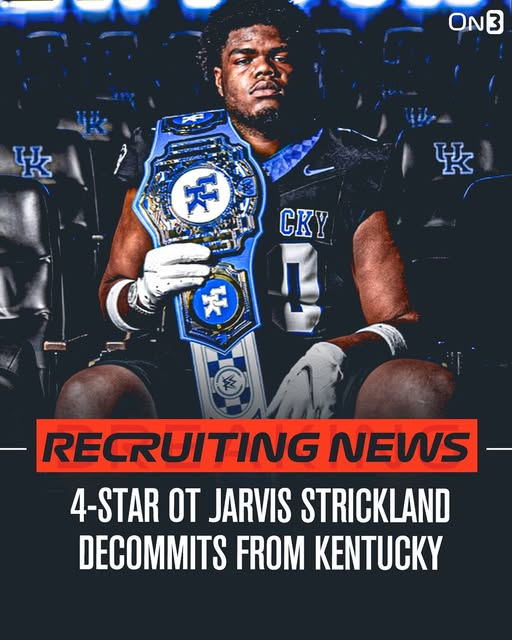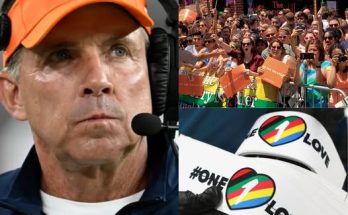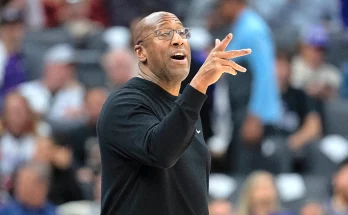In a move that has sent ripples throughout the college football recruiting landscape, Jarvis Strickland—the No. 1 ranked offensive tackle in Kentucky and a key figure in the Wildcats’ 2026 class—has officially announced his decommitment from the University of Kentucky. Strickland’s decision comes as a major blow to Mark Stoops and his coaching staff, who had made the in-state lineman a cornerstone of their long-term vision for the program.
Strickland, who hails from Louisville’s Trinity High School, had been considered a rock-solid pledge for the Wildcats since his verbal commitment earlier this year. At 6-foot-5 and 305 pounds, he possesses a rare blend of size, footwork, and tenacity that made him one of the most coveted linemen in the Southeast. Ranked a top-200 national prospect and the No. 17 offensive tackle in the 2026 class according to multiple recruiting services, Strickland’s commitment had been seen as a major recruiting victory for Kentucky—not just because of his talent, but also due to the importance of keeping elite prospects within state lines.
With his departure, the Wildcats now face the harsh reality of having zero in-state commitments in a class that was already lagging behind in momentum compared to their SEC peers. Strickland’s decommitment underscores a concerning trend for Kentucky: the difficulty of holding onto top-tier talent amid relentless pressure from national powerhouses and the ever-evolving dynamics of NIL (Name, Image, and Likeness) deals and transfer portal leverage.
While Strickland has not yet publicly revealed which programs are now on his radar, sources close to the recruitment suggest that several major schools have already reached out. Programs such as Georgia, Michigan, Alabama, Ohio State, and Tennessee had previously shown strong interest prior to his commitment to Kentucky and are expected to re-engage aggressively now that he is back on the market. Additionally, Louisville—his hometown school—could emerge as a major player moving forward, particularly with their renewed emphasis on landing in-state talent under head coach Jeff Brohm.
For Kentucky, the timing could not be worse. The Wildcats have faced recent struggles on the recruiting trail, particularly in the trenches, where securing elite offensive linemen has been critical to their past success. Strickland was not only a symbolic win in the battle for local talent but also a potential anchor for a future offensive line that could contend in the rugged SEC. His departure now leaves a glaring hole that the staff will need to scramble to fill, with limited in-state options of comparable caliber remaining in the 2026 cycle.
Beyond the Xs and Os, Strickland’s decision also highlights the shifting priorities of top high school athletes in the NIL era. While Kentucky has made strides in NIL infrastructure, the program continues to battle uphill against SEC bluebloods who can offer larger markets, deeper donor bases, and stronger national platforms. For prospects like Strickland, these factors are not just attractive—they’re decisive. The opportunity to elevate one’s brand, secure future earnings, and play on college football’s biggest stages now carries as much weight as traditional factors like proximity, early playing time, or family loyalty.
Strickland’s decommitment may also serve as a wake-up call for Kentucky’s athletic department and fanbase. While the program has enjoyed relative stability under Stoops, it must now adapt to the demands of the modern recruiting era—an era in which relationships alone are not enough to keep blue-chip talent from exploring their options. The Wildcats must now reassert their presence not only in Kentucky but in neighboring recruiting hotbeds such as Ohio, Indiana, and Tennessee to compensate for potential losses like this one.
In a statement released on social media, Strickland thanked the Kentucky coaching staff for believing in him and supporting his development, but made it clear that he needed to “take a step back and reevaluate what’s best for [his] future.” The tone was respectful, but resolute—indicating that this decision had been building for some time.
Recruiting insiders had begun to notice a shift in tone in recent weeks, with Strickland taking more visits than expected and becoming increasingly tight-lipped about his long-term plans. Though he had been expected to be a vocal peer recruiter for Kentucky’s 2026 class, that role never fully materialized. Some viewed that as an early warning sign. Now, it appears those suspicions were warranted.
There’s no denying the sting of this loss for Kentucky. Not only did the Wildcats lose their highest-rated 2026 commit, but they also lost a player with deep roots in the state’s football culture—a player who could have helped define the class and shape the team’s identity moving forward. The fact that Strickland was the only in-state pledge only compounds the impact, raising questions about whether the program is doing enough to build lasting relationships with local standouts in an increasingly competitive climate.
On the flip side, the decision reopens the door for Strickland to explore a recruiting process that had barely begun before he committed. With nearly two full years remaining until National Signing Day for the 2026 class, the four-star lineman now becomes one of the most intriguing uncommitted prospects in the country. His size, athleticism, and versatility—he can play guard or tackle at the next level—make him an immediate target for any school looking to bolster its offensive line pipeline.
Expect campus visits, offers, and media attention to follow in rapid succession. The next chapter of Strickland’s recruiting saga will likely play out in the national spotlight, with fanbases from across the college football spectrum hoping to sway him. For the Wildcats, the task now shifts from celebration to recovery. Can they get back in the race? Can they replace what they lost? And more importantly, can they keep this decommitment from triggering a broader collapse of momentum in the 2026 cycle?
Strickland’s decommitment will almost certainly serve as a cautionary tale for programs around the country, especially those in the SEC East, where the margins between success and stagnation are razor-thin. In a conference where even mid-tier programs are landing top-100 talent, losing an in-state four-star tackle isn’t just unfortunate—it’s potentially program-altering.
The fallout from this decision will extend far beyond Kentucky’s recruiting board. It’s a reminder of how volatile and competitive modern recruiting has become. One decision from one player can reshape the outlook of an entire class, force coaching staffs to pivot strategies, and cause fans to reevaluate their expectations. Kentucky now finds itself in that exact position, reeling from a high-profile decommitment and facing the unenviable task of repairing the damage before it spreads.
Still, all is not lost for the Wildcats. Strickland has not ruled out reconsidering Kentucky in the future, and the door remains slightly ajar—though just barely. If the staff can demonstrate progress on the field this fall and enhance their NIL appeal, they may yet have a chance to regain footing in the race.
In the ever-evolving chess match that is college football recruiting, every move counts—and right now, Kentucky is on the defensive. Jarvis Strickland’s decision to decommit is more than just a headline; it’s a pivotal moment in the Wildcats’ recruiting narrative, one that will test the program’s resilience, creativity, and commitment to competing at the highest level.
As for Strickland, the next phase of his journey begins now. The offers will flood in, the visits will stack up, and his every move will be dissected by coaches, fans, and analysts alike. He may have stepped away from one commitment, but he’s stepped into the national spotlight. Where he ultimately lands remains to be seen—but one thing is certain: Jarvis Strickland is no longer Kentucky’s future. And that changes everything.


